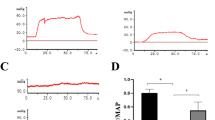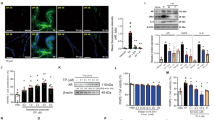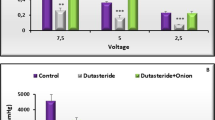Abstract
Radiotherapy (RT) for prostate cancer (PC) can cause erectile dysfunction (ED) by damaging neurovascular structures with oxidative stress. In this study, we evaluated the effects of resveratrol, an antioxidant, on post-RT ED. Fifty rats in five groups were evaluated; control (C), prostate-confined radiotherapy with short- and long-term vehicle or resveratrol treatment. Cavernosal tissues were obtained to analyze glutathione (GSH), nitric oxide (NO), cyclic guanosine monophosphate (cGMP), 8-hydroxy-2′-deoxy-guanosine (8-OHdG) levels and superoxide dismutase (SOD), caspase-3 activities, sirtuin-1, Foxo-3, nNOS, and eNOS protein expressions. Intracavernosal pressures (ICP) were measured for the long-term treatment group. In the RT + long-term vehicle treatment group, tissue GSH, NO, cGMP, and SOD activity were decreased while 8-OHdg levels and caspase-3 activities were increased. Radiotherapy caused a decrease in sirtuin-1, nNOS, and eNOS protein expressions. These parameters were reversed by resveratrol treatment. Foxo-3 protein expressions were unaltered in the RT + short-term vehicle treatment group and started to increase as a defense mechanism in the RT + long-term vehicle group; however, resveratrol treatment caused a significant increase in Foxo-3 expressions. Resveratrol preserved the metabolic pathways involved in erectile function and provided functional protection. Resveratrol can be used as a supplementary agent in patients undergoing radiotherapy to preserve erectile function.
This is a preview of subscription content, access via your institution
Access options
Subscribe to this journal
Receive 8 print issues and online access
$259.00 per year
only $32.38 per issue
Buy this article
- Purchase on Springer Link
- Instant access to full article PDF
Prices may be subject to local taxes which are calculated during checkout




Similar content being viewed by others
References
Heidenreich A, Bastian PJ, Bellmunt J, Bolla M, Joniau S, van der Kwast T, et al. EAU guidelines on prostate cancer. part 1: screening, diagnosis, and local treatment with curative intent-update 2013. Eur Urol. 2014;65:124–37.
Cupps RE, Utz DC, Fleming TR, Carson CC, Zincke H, Myers RP. Definitive radiation therapy for prostatic carcinoma: Mayo clinic experience. J Urol. 1980;124:855–9.
Kiesling VJ, McAninch JW, Goebel JL, Agee RE. External beam radiotherapy for adenocarcinoma of the prostate: a clinical followup. J Urol. 1980;124:851–4.
Akbal C, Tinay I, Simsek F, Turkeri LN. Erectile dysfunction following radiotherapy and brachytherapy for prostate cancer: pathophysiology, prevention and treatment. Int Urol Nephrol. 2008;40:355–63.
Smith DS, Carvalhal GF, Schneider K, Krygiel J, Yan Y, Catalona WJ. Quality-of-life outcomes for men with prostate carcinoma detected by screening. Cancer. 2000;88:1454–63.
Pisansky TM, Pugh SL, Greenberg RE, Pervez N, Reed DR, Rosenthal SA, et al. Tadalafil for prevention of erectile dysfunction after radiotherapy for prostate cancer: the Radiation Therapy Oncology Group [0831] randomized clinical trial. JAMA. 2014;311:1300–7.
Candy B, Jones L, Williams R, Tookman A, King M. Phosphodiesterase type 5 inhibitors in the management of erectile dysfunction secondary to treatments for prostate cancer: findings from a Cochrane systematic review. BJU Int. 2008;102:426–31.
Kimura M, Yan H, Rabbani Z, Satoh T, Baba S, Yin FF, et al. Radiation-induced erectile dysfunction using prostate-confined modern radiotherapy in a rat model. J Sex Med. 2011;8:2215–26.
Mendenhall WM, Henderson RH, Indelicato DJ, Keole SR, Mendenhall NP. Erectile dysfunction after radiotherapy for prostate cancer. Am J Clin Oncol. 2009;32:443–7.
van der Wielen GJ, Vermeij M, de Jong BW, Schuit M, Marijnissen J, Kok DJ, et al. Changes in the penile arteries of the rat after fractionated irradiation of the prostate: a pilot study. J Sex Med. 2009;6:1908–13.
Konopacka M, Rogolinski J, Slosarek K. Bystander effects induced by direct and scattered radiation generated during penetration of medium inside a water phantom. Rep Pract Oncol Radiother. 2011;16:256–61.
Azzam EI, de Toledo SM, Little JB. Oxidative metabolism, gap junctions and the ionizing radiation-induced bystander effect. Oncogene. 2003;22:7050–7.
Marin A, Martin M, Linan O, Alvarenga F, Lopez M, Fernandez L, et al. Bystander effects and radiotherapy. Rep Pract Oncol Radiother. 2015;20:12–21.
Raviraj J, Bokkasam VK, Kumar VS, Reddy US, Suman V. Radiosensitizers, radioprotectors, and radiation mitigators. Indian J Dent Res. 2014;25:83–90.
Kovac JR, DeYoung L, Lehmann KJ, Chung E, Brock GB. The effects of combined free radical scavenger and sildenafil therapy on age-associated erectile dysfunction: an animal model. Urol Ann. 2014;6:314–20.
Lin F, Gou X. Panax notoginseng saponins improve the erectile dysfunction in diabetic rats by protecting the endothelial function of the penile corpus cavernosum. Int J Impot Res. 2013;25:206–11.
Murat N, Korhan P, Kizer O, Evcim S, Kefi A, Demir O, et al. Resveratrol protects and restores endothelium-dependent relaxation in hypercholesterolemic rabbit corpus cavernosum. J Sex Med. 2016;13:12–21.
Hong SH, Lee HJ, Sohn EJ, Ko HS, Shim BS, Ahn KS, et al. Anti-nephrolithic potential of resveratrol via inhibition of ROS, MCP-1, hyaluronan and osteopontin in vitro and in vivo. Pharmacol Rep. 2013;65:970–9.
Penalver P, Belmonte-Reche E, Adan N, Caro M, Mateos-Martin ML, Delgado M, et al. Alkylated resveratrol prodrugs and metabolites as potential therapeutics for neurodegenerative diseases. Eur J Med Chem. 2018;146:123–38.
Seyyedebrahimi S, Khodabandehloo H, Nasli Esfahani E, Meshkani R. The effects of resveratrol on markers of oxidative stress in patients with type 2 diabetes: a randomized, double-blind, placebo-controlled clinical trial. Acta Diabetol. 2018;55:341–53.
Soner BC, Murat N, Demir O, Guven H, Esen A, Gidener S. Evaluation of vascular smooth muscle and corpus cavernosum on hypercholesterolemia. Is resveratrol promising on erectile dysfunction? Int J Impot Res. 2010;22:227–33.
Kimura M, Zodda AR, Mahmood J, Das SK, Nguyen GB, Jackson IL, et al. Pilot study evaluating a rat model of radiation-induced erectile dysfunction using an image-guided microirradiator. Urology. 2015;85:1214 e1211–16.
Mahmood J, Connors CQ, Alexander AA, Pavlovic R, Samanta S, Soman S, et al. Cavernous nerve injury by radiation therapy may potentiate erectile dysfunction in rats. Int J Radiat Oncol Biol Phys. 2017;99:680–8.
Elbe H, Gul M, Cetin A, Taslidere E, Ozyalin F, Turkoz Y, et al. Resveratrol reduces light and electron microscopic changes in acetaminophen-induced hepatotoxicity in rats: role of iNOS expression. Ultrastruct Pathol. 2018;42:39–48.
Bagatini PB, Xavier LL, Bertoldi K, Moyses F, Lovatel G, Neves LT, et al. An evaluation of aversive memory and hippocampal oxidative status in streptozotocin-induced diabetic rats treated with resveratrol. Neurosci Lett. 2017;636:184–9.
Mullerad M, Donohue JF, Li PS, Scardino PT, Mulhall JP. Functional sequelae of cavernous nerve injury in the rat: is there model dependency. J Sex Med. 2006;3:77–83.
Beutler E, Gelbart T. Improved assay of the enzymes of glutathione synthesis: gamma-glutamylcysteine synthetase and glutathione synthetase. Clin Chim Acta. 1986;158:115–23.
Mylroie AA, Collins H, Umbles C, Kyle J. Erythrocyte superoxide dismutase activity and other parameters of copper status in rats ingesting lead acetate. Toxicol Appl Pharmacol. 1986;82:512–20.
Bradford MM. A rapid and sensitive method for the quantitation of microgram quantities of protein utilizing the principle of protein-dye binding. Anal Biochem. 1976;72:248–54.
Luengo-Fernandez R, Leal J, Gray A, Sullivan R. Economic burden of cancer across the European Union: a population-based cost analysis. Lancet Oncol. 2013;14:1165–74.
De Angelis R, Sant M, Coleman MP, Francisci S, Baili P, Pierannunzio D, et al. Cancer survival in Europe 1999-2007 by country and age: results of EUROCARE--5-a population-based study. Lancet Oncol. 2014;15:23–34.
Vanneste BG, Van Limbergen EJ, van Lin EN, van Roermund JG, Lambin P. Prostate cancer radiation therapy: what do clinicians have to know? Biomed Res Int. 2016;2016:6829875.
Donovan JL, Hamdy FC, Lane JA, Mason M, Metcalfe C, Walsh E, et al. Patient-reported outcomes after monitoring, surgery, or radiotherapy for prostate cancer. N Eng J Med. 2016;375:1425–37.
Brown MW, Brooks JP, Albert PS, Poggi MM. An analysis of erectile function after intensity modulated radiation therapy for localized prostate carcinoma. Prostate Cancer Prostatic Dis. 2007;10:189–93.
Zhao W, Diz DI, Robbins ME. Oxidative damage pathways in relation to normal tissue injury. Br J Radiol. 2007;80:S23–31. Spec No1
Goswami SK, Gangadarappa SK, Vishwanath M, Razdan R, Jamwal R, Bhadri N, et al. Antioxidant potential and ability of phloroglucinol to decrease formation of advanced glycation end products increase efficacy of sildenafil in diabetes-induced sexual dysfunction of rats. Sex Med. 2016;4:e104–12.
Tavukcu HH, Sener TE, Tinay I, Akbal C, Ersahin M, Cevik O, et al. Melatonin and tadalafil treatment improves erectile dysfunction after spinal cord injury in rats. Clin Exp Pharmacol Physiol. 2014;41:309–16.
Kimura M, Rabbani ZN, Zodda AR, Yan H, Jackson IL, Polascik TJ, et al. Role of oxidative stress in a rat model of radiation-induced erectile dysfunction. J Sex Med. 2012;9:1535–49.
Ferrini MG, Davila HH, Valente EG, Gonzalez-Cadavid NF, Rajfer J. Aging-related induction of inducible nitric oxide synthase is vasculo-protective to the arterial media. Cardiovasc Res. 2004;61:796–805.
Jesmin S, Sakuma I, Salah-Eldin A, Nonomura K, Hattori Y, Kitabatake A. Diminished penile expression of vascular endothelial growth factor and its receptors at the insulin-resistant stage of a type II diabetic rat model: a possible cause for erectile dysfunction in diabetes. J Mol Endocrinol. 2003;31:401–18.
Oberley-Deegan RE, Steffan JJ, Rove KO, Pate KM, Weaver MW, Spasojevic I, et al. The antioxidant, MnTE-2-PyP, prevents side-effects incurred by prostate cancer irradiation. PLoS ONE. 2012;7:e44178.
Yazir Y, Utkan T, Sahin TD, Gocmez SS. Improvement of penile neurogenic and endothelial relaxant responses by chronic administration of resveratrol in rabbits exposed to unpredictable chronic mild stress. Int J. Impot Res. 2018. Jan 30. https://doi.org/10.1038/s41443-018-0016-8. [Epub ahead of print]
Qiu X, Villalta J, Ferretti L, Fandel TM, Albersen M, Lin G, et al. Effects of intravenous injection of adipose-derived stem cells in a rat model of radiation therapy-induced erectile dysfunction. J Sex Med. 2012;9:1834–41.
Howitz KT, Bitterman KJ, Cohen HY, Lamming DW, Lavu S, Wood JG, et al. Small molecule activators of sirtuins extend Saccharomyces cerevisiae lifespan. Nature. 2003;425:191–6.
Tomada I, Tomada N, Almeida H, Neves D. Androgen depletion in humans leads to cavernous tissue reorganization and upregulation of Sirt1-eNOS axis. Age. 2013;35:35–47.
Milne JC, Denu JM. The Sirtuin family: therapeutic targets to treat diseases of aging. Curr Opin Chem Biol. 2008;12:11–17.
Park SJ, Ahmad F, Philp A, Baar K, Williams T, Luo H, et al. Resveratrol ameliorates aging-related metabolic phenotypes by inhibiting cAMP phosphodiesterases. Cell. 2012;148:421–33.
Xia N, Strand S, Schlufter F, Siuda D, Reifenberg G, Kleinert H, et al. Role of SIRT1 and FOXO factors in eNOS transcriptional activation by resveratrol. Nitric Oxide. 2013;32:29–35.
Funding
This study was supported by Marmara University Scientific Research Projects Committee with the grant number SAG-B-100914–0311.
Author information
Authors and Affiliations
Corresponding author
Ethics declarations
Conflict of interest
The authors declare that they have no conflict of interest.
Rights and permissions
About this article
Cite this article
Sener, T.E., Tavukcu, H.H., Atasoy, B.M. et al. Resveratrol treatment may preserve the erectile function after radiotherapy by restoring antioxidant defence mechanisms, SIRT1 and NOS protein expressions. Int J Impot Res 30, 179–188 (2018). https://doi.org/10.1038/s41443-018-0042-6
Received:
Revised:
Accepted:
Published:
Issue Date:
DOI: https://doi.org/10.1038/s41443-018-0042-6
This article is cited by
-
The sirtuin family in health and disease
Signal Transduction and Targeted Therapy (2022)
-
Exercise and caloric restriction improve cardiovascular and erectile function in rats with metabolic syndrome
International Journal of Impotence Research (2021)
-
Effects of resveratrol on mitochondrial biogenesis and physiological diseases
Advances in Traditional Medicine (2021)
-
Mesenchymal stem cell therapy improves erectile dysfunction in experimental spinal cord injury
International Journal of Impotence Research (2020)



